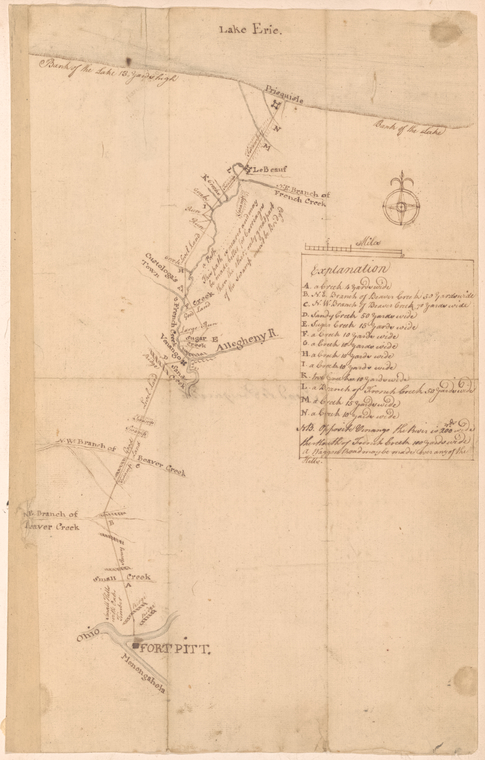Transportation, Communications, and Colonial War
War was nearly unrelenting in colonial America. Europeans fought Europeans from other empires. They fought Indians. And sometimes, alliances of Indian groups and Europeans faced off against each other. The British Empire emerged victorious from nearly a-century-and-a-half of colonial warfare, which culminated in the Seven Years’ War (the American theater of which is better known as the French and Indian War). They won that contest for Eastern North America with guns and money, of course, but also by building effective transportation, communication, and intelligence networks.
The strategic heart of the Seven Years’ War lay in the Ohio Country--especially the area running from backcountry Pennsylvania, north to Lake Erie, and west as far as Detroit. It was in this riverine world that Imperial armies, land-hungry colonists, and Indian groups all converged, with violent results. Far from their coastal strongholds, British success depended on successfully transporting supplies, munitions, and information. So they obsessed over transportation routes. This unattributed hand-drawn map comes from the recently digitized “Papers Relating to Philadelphia” in the Library’s George Chalmers collection. It documents the roads and waterways between Fort Pitt (modern-day Pittsburgh) and Presqu'Isle, in Lake Erie. The map even contains notations of obstacles on certain paths, which routes could best handle carriages, and improvements that might make various spurs more efficient. This attention to detail was characteristic.
Every few days during the summer of 1760, Henry Boquet, a British officer, wrote detailed letters to his superiors about transportation in the region. Boquet’s main concern was shoring up “the communications with The Ohio,” especially roads linking Fort Pitt with Maryland, Virginia, and eastern Pennsylvania. The problem, he surmised, was that two roads already served this purpose. Maintaining both demanded precious manpower. In three detailed pages, Boquet advocated abandoning these roads and creating one new road, routed “in such a manner as to serve equally these three Provinces.” It would ideally run through population centers that could take some responsibility for road maintenance.
To build the case for the new road, Boquet wrote frequent letters to other officials describing problems with existing transportation routes. In mid-June, he complained about impassable roads that often left waggons stalled. A few days earlier, he had noted that “Wheelwrights are much wanted … as several waggons are daily breaking.” Nor did Boquet focus solely on overland travel. In a July letter, he discussed efforts to acquire whale boats along the Niagara River.
As Bouquet made clear, a desire to strengthen communications “with the Ohio” animated his efforts. He had assigned George Croghan with gathering intelligence about French movement in the region. Though not a military man, Croghan was a good fit for the task because of his background as a fur trader, which meant he had existing economic relationships with Indians. The British relied on Indians to get places they could not, and ferry information back from near French outposts.
Croghan served as the main point of contact, vetting the information that his Indian contacts collected. When Croghan passed along intelligence, he might vouch for an informant as “an Indian of good Reputation who I had imployed[sic] last Fall to bring … notice of any designs the Enemy might form against us.” On another occassion he described his source as “A Six Nations Indian who has lived many years among the Wyandotte.” The point was to establish the credibility of their reports. An imperial world war turned on Britain’s ability to establish the veracity of this sort of intelligence and transmit it efficiently, deep in the American backcountry.
The Seven Years’ War was a conventional war of manpower, resources, and strategy. But due to the scarcity of established channels for information exchange, it was also a war in which knowledge was powerful. Having reliable sources of information, and transportation infrastructure on which to transmit separated winners from losers.
Further Reading
On the importance of information to colonization in other parts of North America, see Katherine Grandjean, American Passage: The Communications Frontier in Early New England (Cambridge, MA: Harvard University Press, 2015); and Alejandra Dubcovsky, Informed Power: Communication in the Early American South (Cambridge, MA: Harvard University Press, 2016).
About the Early American Manuscripts Project
With support from the The Polonsky Foundation, The New York Public Library is currently digitizing upwards of 50,000 pages of historic early American manuscript material. The Early American Manuscripts Project will allow students, researchers, and the general public to revisit major political events of the era from new perspectives and to explore currents of everyday social, cultural, and economic life in the colonial, revolutionary, and early national periods. The project will present on-line for the first time high quality facsimiles of key documents from America’s Founding, including the papers of George Washington, Thomas Jefferson, Alexander Hamilton and James Madison. Drawing on the full breadth of the Library’s manuscript collections, it will also make widely available less well-known manuscript sources, including business papers of Atlantic merchants, diaries of people ranging from elite New York women to Christian Indian preachers, and organizational records of voluntary associations and philanthropic organizations. Over the next two years, this trove of manuscript sources, previously available only at the Library, will be made freely available through nypl.org.
Read E-Books with SimplyE
 With your library card, it's easier than ever to choose from more than 300,000 e-books on SimplyE, The New York Public Library's free e-reader app. Gain access to digital resources for all ages, including e-books, audiobooks, databases, and more.
With your library card, it's easier than ever to choose from more than 300,000 e-books on SimplyE, The New York Public Library's free e-reader app. Gain access to digital resources for all ages, including e-books, audiobooks, databases, and more.
If you don’t have an NYPL library card, New York State residents can apply for a digital card online or through SimplyE (available on the App Store or Google Play).
Need more help? Read our guide to using SimplyE.




